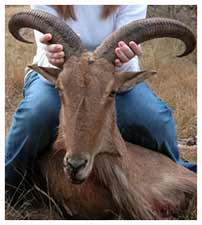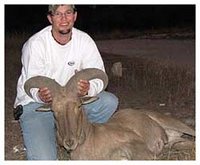Hunting Tips, Questions, Stories & Discussion
Focusing on managing Texas wildlife habitat and natural resources for native and exotic wild game species, for this and future generation of hunters and outdoor enthusiasts.Monday, June 22, 2009
I thought that these sheep did best in mountainous areas, how does that fit in for south Texas aoudad populations?
The south Texas Aoudad sheep are no less athletic than those that range into the mountains in Texas as well as New Mexico. The hill  country sheep are just as wily, alert and highly intelligent as those that live in the much more remote areas of the state. The south Texas Aoudads that live on managed game ranches often are slightly larger than the free range members of the species, plus they are not over hunted or decimated by extreme weather conditions or disease that can occur in wild herds.
country sheep are just as wily, alert and highly intelligent as those that live in the much more remote areas of the state. The south Texas Aoudads that live on managed game ranches often are slightly larger than the free range members of the species, plus they are not over hunted or decimated by extreme weather conditions or disease that can occur in wild herds.
Other than south Texas Aoudad sheep on managed game ranches or exotic game ranches, are there a lot in the wild?
For people that aren't used to the miles and miles of unfenced land in south and west Texas it may be surprising to know that most south Texas Aoudad sheep are actually on free range, not confined to a game ranches in the true sense. These game leases or ranches can run for literally hundreds of square miles of brush, rugged country and dirt roads. It is estimated that the original Barbary or Aoudad sheep that were brought over from Africa after World War ll quickly escaped from their fenced pastures and immediately began populating these huge grazing ranges and leases.
Based on different studies that include a lot of extrapolation from actual hard numbers, it is estimated by researchers that there are over 25,000 central, west and south Texas Aoudad sheep living in unconfined pastures and on grazing and hunting leases. The number of captive or contained Aoudad is not known, however they are likely to total at least another 10,000 or so animals.
What is the difference between shooting a male or a female south Texas Aoudad?
If you are looking for a lot of sporting opportunity there is really no difference between either the male or female when it comes to south Texas Aoudad hunts. In general the female is going to be lighter in total body weight plus she will not have the huge trophy horns that you could possibly get if you decided to go for a ram.
The females also don't have the distinguishing chaps, the heavy, long growth of hair on the front of the legs. Females don't have the highly prominent beard either, however they still make a terrific head mount or horn mount, your choice.
Labels: aoudad hunting, aoudad sheep hunting, texas aoudad hunts, trophy aoudad sheep
Wednesday, December 31, 2008
What is the average lifespan of the Aoudad Sheep?
 In the wild under good conditions the Aoudad sheep can live to be up to 20 years, longer in captivity. They are very hardy and are not susceptible to the drought and low forage problems that can affect the native species. They can actually go without water for long periods of time and their bodies are able to extract enough water to survive from meager amounts of vegetation.
In the wild under good conditions the Aoudad sheep can live to be up to 20 years, longer in captivity. They are very hardy and are not susceptible to the drought and low forage problems that can affect the native species. They can actually go without water for long periods of time and their bodies are able to extract enough water to survive from meager amounts of vegetation.The main breeding season runs from the first part of September through to the end of November with offspring born from March through to May. Like many species, the Aoudad can breed throughout the year and females will come into season between 18 months and 2 years of age.
Newborn sheep are extremely athletic and can climb around on very rocky and rough terrain
within just a few minutes after birth. The females are very protective of their young and keep them close by until about 4 months of age when they are weaned.
Labels: aoudad hunting, barbary sheep hunting, texas hunting ranch, trophy aoudad sheep
Archives
December 2008 January 2009 February 2009 April 2009 May 2009 June 2009 July 2009 August 2009 September 2009 November 2009 December 2009 January 2010 February 2010 March 2010 April 2010
Subscribe to Posts [Atom]
